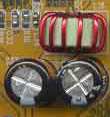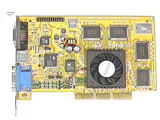Leadtek Winfast 3D S320 II-32 TNT2 32MB SGRAM
by Mike Andrawes on May 26, 1999 1:34 AM EST- Posted in
- GPUs
The Card
The Winfast 3D S320 II is available in four unique configurations, the differentiating qualities among them being memory size and the presence of a digital LCD out port. The card AnandTech will be taking a look at in this review is the Winfast 3D S320 II-32, a TNT2 based part outfitted with 32MB of SGRAM, but not the digital LCD out port.
 The
card is based closely upon NVIDIA's reference TNT2 design with a few modifications,
such as the addition of a toroidial inductor and two big (for a video card)
capacitors at the edge of the first SGRAM chip designed to maintain the strength
of the electrical current as well as limit the amount of "noise" present in
the signal. Other than that particular addition, which shifted the components
on the S320-II around a bit, the card is based closely upon NVIDIA's reference
design and should therefore be very similar to the majority of SGRAM cards out
there.
The
card is based closely upon NVIDIA's reference TNT2 design with a few modifications,
such as the addition of a toroidial inductor and two big (for a video card)
capacitors at the edge of the first SGRAM chip designed to maintain the strength
of the electrical current as well as limit the amount of "noise" present in
the signal. Other than that particular addition, which shifted the components
on the S320-II around a bit, the card is based closely upon NVIDIA's reference
design and should therefore be very similar to the majority of SGRAM cards out
there.
The memory configuration on AnandTech's sample, as discussed earlier, was a 32MB setup which was composed of four 4MB Samsung 7ns SGRAM chips on each side of the board. The default memory clock was set at 150MHz, although AnandTech's sample was capable of running the memory at 170MHz. After a few discussions with competing TNT2 manufacturers, it seems like some of the most popular SDRAM suppliers for TNT2 boards will be Samsung, Micron, and a not so well known manufacturer, MIRA. While AnandTech's board, equipped with Samsung chips made it up to 170MHz, the same may not be true for boards outfitted with non-Samsung modules.
Basically, when it comes to video cards, the manufacturer usually opts for the best deal they can get on memory in large quantities, so if one day Samsung SGRAM grows to be a little more expensive, don't be surprised if board manufacturers turn to other sources for solutions. The only requirement, remember, is to make sure that the memory runs fine at the speed the manufacturer spec'd the board at, and for Leadtek, 150MHz isn't a feat too difficult to achieve.
The Winfast S320 II that is currently available is not an "ultra" TNT2 part, but rather just the plain vanilla TNT2 that NVIDIA recommends clocking at 125MHz core and 150MHz memory. Leadtek is planning to produce an ultra based board that will be available toward the end of May or early June. No word on that clock rate as of now. The regular TNT2 core on the S320 II is clocked at a safe 140MHz setting by default, which is high enough to provide a noticeable improvement over competing 125MHz solutions as well as older TNT and Voodoo2 cards, while low enough to insure proper operation and stability. The majority of competitors TNT2 boards will follow NVIDIA's recommendations and some will include an overclocking slider for your own experimentation.
The 0.25-micron wafers the TNT2 is cut from provide for relatively cool operation, much cooler than the older TNTs and even the new Voodoo3s. They run at a point where a simple passive heatsink would provide adequate cooling for the chip at 140MHz, however it's not surprising that Leadtek went a step further and equipped all members of the S320 II line with a low profile heatsink/fan combo. The fan operates quietly, does not interfere with adjacent cards, and performs a decent job of keeping the TNT2 cool, much better than a heatsink alone. The fansink is attached to the surface of the TNT2 using thermally conductive tape, but for the best cooling performance you may want to replace the tape with a generous amount of thermal grease - the same kind used on CPU heatsinks will do just fine. Using thermal grease (aka heatsink compound) is not a requirement, but for all of you tweakers and overclockers out there it may be something to check out.
Update: Leadtek has supposedly been told by NVIDIA to cut the clock back to the recommended speed of 125/150, but they will still guarantee that all S320 II boards will run at 140/150, but it will need to be done through the overclocking tool included in the drivers. Their internal tests shows that 95% run at 150+/150+ without any problems, and 80% can hit 160+/160+.










0 Comments
View All Comments